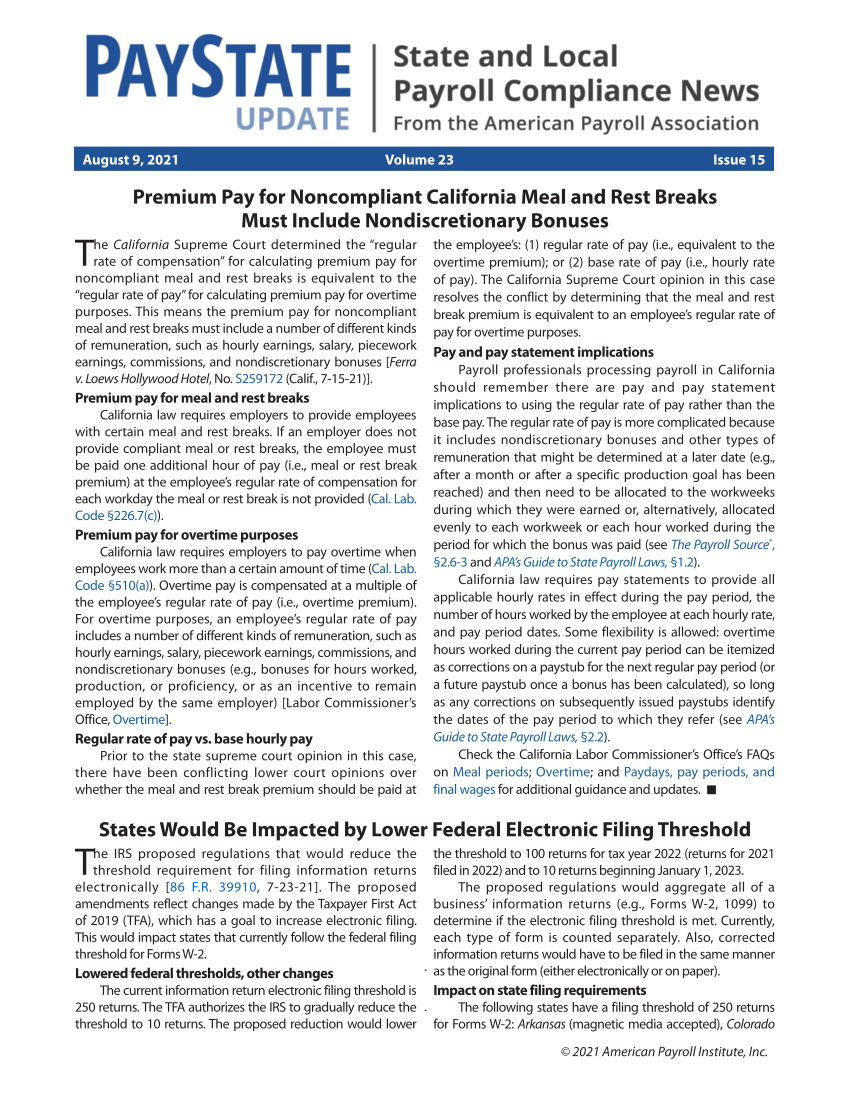© 2021 American Payroll Institute, Inc. Premium Pay for Noncompliant California Meal and Rest Breaks Must Include Nondiscretionary Bonuses The California Supreme Court determined the “regular rate of compensation” for calculating premium pay for noncompliant meal and rest breaks is equivalent to the “regular rate of pay” for calculating premium pay for overtime purposes. This means the premium pay for noncompliant meal and rest breaks must include a number of different kinds of remuneration, such as hourly earnings, salary, piecework earnings, commissions, and nondiscretionary bonuses [Ferra v. Loews Hollywood Hotel, No. S259172 (Calif., 7-15-21)]. Premium pay for meal and rest breaks California law requires employers to provide employees with certain meal and rest breaks. If an employer does not provide compliant meal or rest breaks, the employee must be paid one additional hour of pay (i.e., meal or rest break premium) at the employee’s regular rate of compensation for each workday the meal or rest break is not provided (Cal. Lab. Code §226.7(c)). Premium pay for overtime purposes California law requires employers to pay overtime when employees work more than a certain amount of time (Cal. Lab. Code §510(a)). Overtime pay is compensated at a multiple of the employee’s regular rate of pay (i.e., overtime premium). For overtime purposes, an employee’s regular rate of pay includes a number of different kinds of remuneration, such as hourly earnings, salary, piecework earnings, commissions, and nondiscretionary bonuses (e.g., bonuses for hours worked, production, or proficiency, or as an incentive to remain employed by the same employer) [Labor Commissioner’s Office, Overtime]. Regular rate of pay vs. base hourly pay Prior to the state supreme court opinion in this case, there have been conflicting lower court opinions over whether the meal and rest break premium should be paid at the employee’s: (1) regular rate of pay (i.e., equivalent to the overtime premium) or (2) base rate of pay (i.e., hourly rate of pay). The California Supreme Court opinion in this case resolves the conflict by determining that the meal and rest break premium is equivalent to an employee’s regular rate of pay for overtime purposes. Pay and pay statement implications Payroll professionals processing payroll in California should remember there are pay and pay statement implications to using the regular rate of pay rather than the base pay. The regular rate of pay is more complicated because it includes nondiscretionary bonuses and other types of remuneration that might be determined at a later date (e.g., after a month or after a specific production goal has been reached) and then need to be allocated to the workweeks during which they were earned or, alternatively, allocated evenly to each workweek or each hour worked during the period for which the bonus was paid (see The Payroll Source®, §2.6-3 and APA’s Guide to State Payroll Laws, §1.2). California law requires pay statements to provide all applicable hourly rates in effect during the pay period, the number of hours worked by the employee at each hourly rate, and pay period dates. Some flexibility is allowed: overtime hours worked during the current pay period can be itemized as corrections on a paystub for the next regular pay period (or a future paystub once a bonus has been calculated), so long as any corrections on subsequently issued paystubs identify the dates of the pay period to which they refer (see APA’s Guide to State Payroll Laws, §2.2). Check the California Labor Commissioner’s Office’s FAQs on Meal periods Overtime and Paydays, pay periods, and final wages for additional guidance and updates. States Would Be Impacted by Lower Federal Electronic Filing Threshold The IRS proposed regulations that would reduce the threshold requirement for filing information returns electronically [86 F.R. 39910, 7-23-21]. The proposed amendments reflect changes made by the Taxpayer First Act of 2019 (TFA), which has a goal to increase electronic filing. This would impact states that currently follow the federal filing threshold for Forms W-2. Lowered federal thresholds, other changes The current information return electronic filing threshold is 250 returns. The TFA authorizes the IRS to gradually reduce the threshold to 10 returns. The proposed reduction would lower the threshold to 100 returns for tax year 2022 (returns for 2021 filed in 2022) and to 10 returns beginning January 1, 2023. The proposed regulations would aggregate all of a business’ information returns (e.g., Forms W-2, 1099) to determine if the electronic filing threshold is met. Currently, each type of form is counted separately. Also, corrected information returns would have to be filed in the same manner as the original form (either electronically or on paper). Impact on state filing requirements The following states have a filing threshold of 250 returns for Forms W-2: Arkansas (magnetic media accepted), Colorado August 9, 2021 Volume 23 Issue 15
Printed for: PayrollOrg Bookshelf © 2024 American Payroll Institute, Inc. All Rights reserved. From: PayrollOrg Digital Publications (bookshelf.payroll.org)






